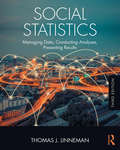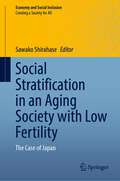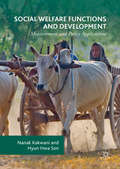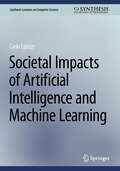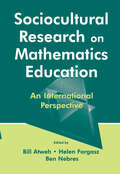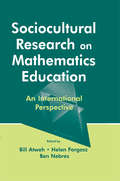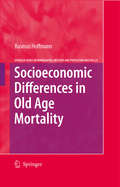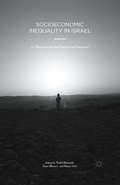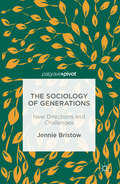- Table View
- List View
Social Statistics: Managing Data, Conducting Analyses, Presenting Results (Sociology Re-Wired)
by Thomas J. LinnemanWith a clear and engaging writing style and strong examples from the real world, this text covers current statistical techniques at an introductory level and emphasizes the clear presentation of results to a variety of audiences, making the course more useful to students and their careers. Interconnection features among chapters help students understand how all of the techniques fit together. Using varied data sets, the text features a highly rated companion website that includes videos of the author offering step-by-step explanations of how to carry out the techniques, interpret the results, and present them to varied audiences. NEW TO THIS EDITION More inter-chapter connections have been added to improve students’ conceptual learning. Several examples (on immigration, health, and civil rights) now permeate the text for easy comparison of techniques across chapters. The section on managing data is considerably expanded to cover topics such as finding new sources of data, dealing with missing data, and how to combine data reliably. Very current examples from the scholarly literature from criminology, education, and health show how researchers use each chapter’s techniques to tell compelling stories. Instructors can choose from a variety of greatly expanded materials to enhance their lectures: engaging animations of key concepts; dynamic demonstrations of how statistics change in line with the data; short lectures on difficult-to-explain topics; and in-class exercises that will help students learn how to make sense of statistical results.
Social Stratification in an Aging Society with Low Fertility: The Case of Japan (Economy and Social Inclusion)
by Sawako ShirahaseThis edited book empirically discusses stratification in contemporary Japanese society. It is unique for its examination of social inequality in relation to declining fertility and an aging population. Japan is the most aged society in the world: according to the Statistics Bureau of Japan, people who are aged 65 and above comprised 29.1% of the country’s total population in 2021. Meanwhile, the fertility rate has continuously declined since the mid-1970s. Japan experienced a dramatic change in its demographic structure in a short period of time. Such fast change could be a major factor that generated social stratification. In her industrialization, Japan was thought to share a pattern of social stratification similar to that of developed European and North American countries but with a low degree of socio-economic inequality and a high degree of homogeneity. There is no clear support for this description of Japan, although the country does share a pattern and degree of social stratification similar to that observed in Europe and North America. The social stratification theory has been developed in close relationship to the labor market; however, it is necessary to further examine the social stratification of very aged societies in which a substantial number of the population—namely, retired persons—no longer have any ties to the labor market. In this book, the contributors explore the pattern of social stratification at three life stages: young, middle-aged, and elderly. Included are discussions of various aspects of stratification such as education, work, wealth, marriage, family, gender, generation, and social attitudes.
Social Systems Engineering: The Design of Complexity (Wiley Series in Computational and Quantitative Social Science)
by César Garc A-D Az Camilo OlayaUniquely reflects an engineering view to social systems in a wide variety of contexts of application Social Systems Engineering: The Design of Complexity brings together a wide variety of application approaches to social systems from an engineering viewpoint. The book defines a social system as any complex system formed by human beings. Focus is given to the importance of systems intervention design for specific and singular settings, the possibilities of engineering thinking and methods, the use of computational models in particular contexts, and the development of portfolios of solutions. Furthermore, this book considers both technical, human and social perspectives, which are crucial to solving complex problems. Social Systems Engineering: The Design of Complexity provides modelling examples to explore the design aspect of social systems. Various applications are explored in a variety of areas, such as urban systems, health care systems, socio-economic systems, and environmental systems. It covers important topics such as organizational design, modelling and intervention in socio-economic systems, participatory and/or community-based modelling, application of systems engineering tools to social problems, applications of computational behavioral modeling, computational modelling and management of complexity, and more. Highlights an engineering view to social systems (as opposed to a “scientific” view) that stresses the importance of systems intervention design for specific and singular settings Divulges works where the design, re-design, and transformation of social systems constitute the main aim, and where joint considerations of both technical and social perspectives are deemed important in solving social problems Features an array of applied cases that illustrate the application of social systems engineering in different domains Social Systems Engineering: The Design of Complexity is an excellent text for academics and graduate students in engineering and social science—specifically, economists, political scientists, anthropologists, and management scientists with an interest in finding systematic ways to intervene and improve social systems.
Social Systems Engineering: The Design of Complexity (Wiley Series in Computational and Quantitative Social Science)
by César García-Díaz Camilo OlayaUniquely reflects an engineering view to social systems in a wide variety of contexts of application Social Systems Engineering: The Design of Complexity brings together a wide variety of application approaches to social systems from an engineering viewpoint. The book defines a social system as any complex system formed by human beings. Focus is given to the importance of systems intervention design for specific and singular settings, the possibilities of engineering thinking and methods, the use of computational models in particular contexts, and the development of portfolios of solutions. Furthermore, this book considers both technical, human and social perspectives, which are crucial to solving complex problems. Social Systems Engineering: The Design of Complexity provides modelling examples to explore the design aspect of social systems. Various applications are explored in a variety of areas, such as urban systems, health care systems, socio-economic systems, and environmental systems. It covers important topics such as organizational design, modelling and intervention in socio-economic systems, participatory and/or community-based modelling, application of systems engineering tools to social problems, applications of computational behavioral modeling, computational modelling and management of complexity, and more. Highlights an engineering view to social systems (as opposed to a “scientific” view) that stresses the importance of systems intervention design for specific and singular settings Divulges works where the design, re-design, and transformation of social systems constitute the main aim, and where joint considerations of both technical and social perspectives are deemed important in solving social problems Features an array of applied cases that illustrate the application of social systems engineering in different domains Social Systems Engineering: The Design of Complexity is an excellent text for academics and graduate students in engineering and social science—specifically, economists, political scientists, anthropologists, and management scientists with an interest in finding systematic ways to intervene and improve social systems.
Social Trends in American Life: Findings from the General Social Survey since 1972
by Peter V. MarsdenSocial Trends in American Life assembles a team of leading researchers to provide unparalleled insight into how American social attitudes and behaviors have changed since the 1970s. Drawing on the General Social Survey--a social science project that has tracked demographic and attitudinal trends in the United States since 1972--it offers a window into diverse facets of American life, from intergroup relations to political views and orientations, social affiliations, and perceived well-being. Among the book's many important findings are the greater willingness of ordinary Americans to accord rights of free expression to unpopular groups, to endorse formal racial equality, and to accept nontraditional roles for women in the workplace, politics, and the family. Some, but not all, signs indicate that political conservatism has grown, while a few suggest that Republicans and Democrats are more polarized. Some forms of social connectedness such as neighboring have declined, as has confidence in government, while participation in organized religion has softened. Despite rising standards of living, American happiness levels have changed little, though financial and employment insecurity has risen over three decades. Social Trends in American Life provides an invaluable perspective on how Americans view their lives and their society, and on how these views have changed over the last two generations.
Social Trends in American Life: Findings from the General Social Survey since 1972
by Peter V. MarsdenSocial Trends in American Life assembles a team of leading researchers to provide unparalleled insight into how American social attitudes and behaviors have changed since the 1970s. Drawing on the General Social Survey--a social science project that has tracked demographic and attitudinal trends in the United States since 1972--it offers a window into diverse facets of American life, from intergroup relations to political views and orientations, social affiliations, and perceived well-being. Among the book's many important findings are the greater willingness of ordinary Americans to accord rights of free expression to unpopular groups, to endorse formal racial equality, and to accept nontraditional roles for women in the workplace, politics, and the family. Some, but not all, signs indicate that political conservatism has grown, while a few suggest that Republicans and Democrats are more polarized. Some forms of social connectedness such as neighboring have declined, as has confidence in government, while participation in organized religion has softened. Despite rising standards of living, American happiness levels have changed little, though financial and employment insecurity has risen over three decades. Social Trends in American Life provides an invaluable perspective on how Americans view their lives and their society, and on how these views have changed over the last two generations.
Social Welfare Functions and Development: Measurement and Policy Applications
by Nanak Kakwani Hyun Hwa SonNanak Kakwani and Hyun Hwa Son make use of social welfare functions to derive indicators of development relevant to specific social objectives, such as poverty- and inequality-reduction. Arguing that the measurement of development cannot be value-free, the authors assert that if indicators of development are to have policy relevance, they must be assessed on the basis of the social objectives in question. This study develops indicators that are sensitive to both the level and the distribution of individuals’ capabilities. The idea of the social welfare function, defined in income space, is extended to the concept of the social well-being function, defined in capability space. Through empirical analysis from selected developing countries, with a particular focus on Brazil, the authors shape techniques appropriate to the analysis of development in different dimensions. The focus of this evidence-based policy analysis is to evaluate alternative policies affecting the capacities of people to enjoy a better life.
Societal Impacts of Artificial Intelligence and Machine Learning (Synthesis Lectures on Computer Science)
by Carlo LipizziThis book goes beyond the current hype of expectations generated by the news on artificial intelligence and machine learning by analyzing realistic expectations for society, its limitations, and possible future scenarios for the use of this technology in our current society. Artificial Intelligence is one of the top topics today and is inflating expectations beyond what the technology can do in the foreseeable future. The future cannot be predicted, but the future of some elements of our society, such as technology, can be estimated. This book merges the modeling of human reasoning with the power of AI technology allowing readers to make more informed decisions about their personal or financial decisions or just being more educated on current technologies. This book presents a model that sketches potential future scenarios based on a discussion of the expectations today, the analysis of the current gap in the literature, and a view of possible futures in terms of technology and use cases. Specifically, this book merges literature on the technology aspects, the sociological impacts, and philosophical aspects.
Socio-cultural Inspired Metaheuristics (Studies in Computational Intelligence #828)
by Kang Tai Suresh Chandra Satapathy Anand J. Kulkarni Pramod Kumar Singh Ali Husseinzadeh KashanThis book presents the latest insights and developments in the field of socio-cultural inspired algorithms. Akin to evolutionary and swarm-based optimization algorithms, socio-cultural algorithms belong to the category of metaheuristics (problem-independent computational methods) and are inspired by natural and social tendencies observed in humans by which they learn from one another through social interactions. This book is an interesting read for engineers, scientists, and students studying/working in the optimization, evolutionary computation, artificial intelligence (AI) and computational intelligence fields.
The Socio-Economic Impact of Migration Flows: Effects on Trade, Remittances, Output, and the Labour Market (Population Economics)
by Andrés Artal-Tur Giovanni Peri Francisco Requena-SilventeThough globalisation of the world economy is currently a powerful force, people’s international mobility appears to still be very limited. The goal of this book is to improve our knowledge of the true effects of migration flows. It includes contributions by prominent academic researchers analysing the socio-economic impact of migration in a variety of contexts: interconnection of people and trade flows, causes and consequences of capital remittances, understanding the macroeconomic impact of migration and the labour market effects of people’s flows. The latest analytical methodologies are employed in all chapters, while interesting policy guidelines emerge from the investigations. The style of the volume makes it accessible for both non-experts and advanced readers interested in this hot topic of today’s world.
Socio-Inspired Optimization Methods for Advanced Manufacturing Processes (Springer Series in Advanced Manufacturing)
by Apoorva Shastri Aniket Nargundkar Anand J. KulkarniThis book discusses comprehensively the advanced manufacturing processes, including illustrative examples of the processes, mathematical modeling, and the need to optimize associated parameter problems. In addition, it describes in detail the cohort intelligence methodology and its variants along with illustrations, to help readers gain a better understanding of the framework. The theoretical and statistical rigor is validated by comparing the solutions with evolutionary algorithms, simulation annealing, response surface methodology, the firefly algorithm, and experimental work. Lastly, the book critically reviews several socio-inspired optimization methods.
Socio-Spatial Dynamics in Mediterranean Europe: Exploring Metropolitan Structural Processes and Short-term Change (Spatial Demography Book Series #3)
by José María Feria-Toribio Ricardo Iglesias-Pascual Federico BenassiThis book analyses the most recent socio-territorial trends that are developing in the Spanish metropolitan space. The first part focuses on the most recent metropolitan dynamics and demographic changes in Southern Europe. The second part discusses the most important processes in metropolitan areas: the problems of increasing social and residential vulnerability and the problems of diversity management. The third part analyses some concrete cases of the main changes and complexity in the spatial dynamics of metropolitan areas in Southern Europe. Finally, the fourth and last part provides an overview on the instruments and the resources put in place by some Southern European cities for the development of governance and citizen participation as an instrument of reaction to the social, economic and COVID crisis. By discussing the main changes and uncertainties derived from the social scenarios after the pandemic, the dynamics of social dualisation of the city, as well as the necessaryinstruments for its analysis and the main challenges in urban governance with special attention of Southern European context, this book provides an interesting read for spatial demographers, human geographers, social scientists and spatial planners.
Sociocultural Research on Mathematics Education: An International Perspective
by Bill Atweh Helen Forgasz Ben NebresThis volume--the first to bring together research on sociocultural aspects of mathematics education--presents contemporary and international perspectives on social justice and equity issues that impact mathematics education. In particular, it highlights the importance of three interacting and powerful factors--gender, social, and cultural dimensions. Sociocultural Research on Mathematics Education: An International Perspective is distinguished in several ways: * It is research based. Chapters report on significant research projects; present a comprehensive and critical summary of the research findings; and offer a critical discussion of research methods and theoretical perspectives undertaken in the area. * It is future oriented, presenting recommendations for practice and policy and identifying areas for further research. * It deals with all aspects of formal and informal mathematics education and applications and all levels of formal schooling. As the context of mathematics education rapidly changes-- with an increased demand for mathematically literate citizenship; an increased awareness of issues of equity, inclusivity, and accountability; and increased efforts for globalization of curriculum development and research-- questions are being raised more than ever before about the problems of teaching and learning mathematics from a non-cognitive science perspective. This book contributes significantly to addressing such issues and answering such questions. It is especially relevant for researchers, graduate students, and policymakers in the field of mathematics education.
Sociocultural Research on Mathematics Education: An International Perspective
by Bill Atweh Helen Forgasz Ben NebresThis volume--the first to bring together research on sociocultural aspects of mathematics education--presents contemporary and international perspectives on social justice and equity issues that impact mathematics education. In particular, it highlights the importance of three interacting and powerful factors--gender, social, and cultural dimensions. Sociocultural Research on Mathematics Education: An International Perspective is distinguished in several ways: * It is research based. Chapters report on significant research projects; present a comprehensive and critical summary of the research findings; and offer a critical discussion of research methods and theoretical perspectives undertaken in the area. * It is future oriented, presenting recommendations for practice and policy and identifying areas for further research. * It deals with all aspects of formal and informal mathematics education and applications and all levels of formal schooling. As the context of mathematics education rapidly changes-- with an increased demand for mathematically literate citizenship; an increased awareness of issues of equity, inclusivity, and accountability; and increased efforts for globalization of curriculum development and research-- questions are being raised more than ever before about the problems of teaching and learning mathematics from a non-cognitive science perspective. This book contributes significantly to addressing such issues and answering such questions. It is especially relevant for researchers, graduate students, and policymakers in the field of mathematics education.
Sociodemographic Questionnaire Modules for Comparative Social Surveys (SpringerBriefs in Population Studies)
by Jürgen H.P. Hoffmeyer-Zlotnik Uwe WarnerAbove all, this book focuses on the application of sociodemographic survey questions. Based on theoretical foundations, it addresses the operationalization of variables and presents socio-demographic questionnaire modules for within- and across-country comparative survey research. The book pursues three main objectives: to provide a thorough and comprehensive overview of the survey instruments currently available for the measurement of sociodemographic variables in cross-national comparative research; to offer the reader a set of harmonized international demographic standards; and to show how these standards can be implemented by the various parties involved in international comparative surveys – from the central project coordinators, to the researchers on the national survey teams, to the fieldwork agencies and their interviewers, to respondents, and eventually, to the data processing experts preparing the datasets for comparative analysis. The book offers a valuable resource for researchers, practitioners and students actively involved in producing and analyzing sociodemographic survey data. The typical readers will be social science researchers, qualified consultants and professionals interested in the field of (comparative) survey research. The book can also serve as a useful supplement to introductory textbooks on survey methodology and is suitable for Bachelor and Master students of the social sciences.
Socioeconomic Differences in Old Age Mortality (The Springer Series on Demographic Methods and Population Analysis #25)
by Rasmus HoffmannSocial differences in health and mortality constitute a persistent finding in epidemiological, demographic, and sociological research. It is a topic that is much discussed in the current political debate and it is among the most urgent public health issues. However, we still do not know whether socioeconomic mortality differences increase or decrease with age. This book provides a comprehensive, critical discussion of all aspects involved in the relationship between socioeconomic status, health and mortality. It synthesizes the sociological theory of social inequality and an empirical study of mortality differences that has been conducted by the Max Planck Institute for Demographic Research (Rostock, Germany). This study is the most comprehensive analysis of socioeconomic mortality differences in the literature, both in terms of quantity and quality of data, and in terms of the statistical method used: that of event-history modeling.
Socioeconomic Evaluation of Drug Therapy (Health Systems Research)
by BrunoHorisberger WilhelmEimerenModern drugs are invented according to medical needs, making use of the latest innovations in technology. They are sophisticated, efficacious, and costly, but are they effective? Are they superior to existing - and cheaper - alternatives, and is this superiority reflected in increased cost-effectiveness? Are they socially more beneficial? These questions, and those related to the intriguing search for better quality of life, are addressed in this book by experts from the fields of medicine, epidemiology, economics, sociology and the pharmaceutical industry. The book describes the environmental situation in the United States and Europe in which pharmaceutical development takes place; it also explores the grounds for agreement as well as disagreement between the social and the economic evaluations of progress. It tackles the problem of outcome measurements, patients' behavior, quality of life, and individual value judgments and describes methodological boundaries in the socioeconomic evaluation of drugs.
Socioeconomic Inequality and Educational Outcomes: Evidence from Twenty Years of TIMSS (IEA Research for Education #5)
by Markus Broer Yifan Bai Frank FonsecaThis open access book focuses on trends in educational inequality using twenty years of grade 8 student data collected from 13 education systems by the IEA’s Trends in Mathematics and Science Study (TIMSS) between 1995 and 2015. While the overall positive association between family socioeconomic status (SES) and student achievement is well documented in the literature, the magnitude of this relationship is contingent on social contexts and is expected to vary by education system. Research on how such associations differ across societies and how the strength of these relationships has changed over time is limited. This study, therefore, addresses an important research and policy question by examining changes in the inequality of educational outcomes due to SES over this 20-year period, and also examines the extent to which the performance of students from disadvantaged backgrounds has improved over time in each education system. Education systems generally aim to narrow the achievement gap between low- and high-SES students and to improve the performance of disadvantaged students. However, the lack of quantifiable and comprehensible measures makes it difficult to assess and monitor the effect of such efforts. In this study, a novel measure of SES that is consistent across all TIMSS cycles allows students to be categorized into different socioeconomic groups. This measure of SES may also contribute to future research using TIMSS trend data. Readers will gain new insight into how educational inequality has changed in the education systems studied and how such change may relate to the more complex picture of macroeconomic changes in those societies.
Socioeconomic Inequality in Israel: A Theoretical and Empirical Analysis
by Nabil Khattab Sami Miaari Haya StierThis volume addresses different aspects and areas of inequality in Israel, a country characterized by high levels of economic inequality, poverty, and social diversity. The book expands on the mechanisms that produce and maintain inequality, and the role of state policies in influencing those mechanisms.
Socioeconomic Segregation and Educational Inequality: Evidence from International Assessments (IEA Research for Education #15)
by Nathan A. Burroughs Jacqueline A. Gardner Dirk F. Zuschlag Craig Joseph Van VlietThis open access book uses multiple IEA Assessments to examine the relationship between socioeconomic segregation between classrooms and student outcomes. By examining Socioeconomic status (SES) segregation between classrooms as well as between schools, it produces a more accurate estimate of student sorting. Further, this study examines the differential impact of student sorting across subject areas and grades in order to explore whether school structure’s relationship to educational inequality exhibits content and longitudinal heterogeneity. This study employs time series, fixed-effect, random-effects, and synthetic-cohort methods to comprehensively investigate the robustness of the relationship between SES segregation and achievement inequalities. This project makes an important contribution to researchers’ understanding of student sorting’s impact using a comparative lens, while also providing important information to policymakers on the role of schools in mediating social inequalities.
Sociology and Complexity Science: A New Field of Inquiry (Understanding Complex Systems)
by Brian Castellani Frederic William HaffertyBy now, most academics have heard something about the new science of complexity. In a manner reminiscent of Einstein and the last hundred years of physics, complexity science has captured the public imagination. ® One can go to Amazon. com and purchase books on complexification (Casti 1994), emergence (Holland 1998), small worlds (Barabási 2003), the web of life (Capra 1996), fuzzy thinking (Kosko 1993), global c- plexity (Urry 2003) and the business of long-tails (Anderson 2006). Even television has incorporated the topics of complexity science. Crime shows ® ® such as 24 or CSI typically feature investigators using the latest advances in computational modeling to “simulate scenarios” or “data mine” all p- sible suspects—all of which is done before the crime takes place. The ® World Wide Web is another example. A simple search on Google. Com using the phrase “complexity science” gets close to a million hits! C- plexity science is ubiquitous. What most scholars do not realize, however, is the remarkable role sociologists are playing in this new science. C- sider the following examples. 0. 1 Sociologists in Complexity Science The first example comes from the new science of networks (Barabási 2003). By now, most readers are familiar with the phenomena known as six-degrees of separation—the idea that, because most large networks are comprised of a significant number of non-random weak-ties, the nodes (e. g. , people, companies, etc.
Sociology and Statistics in Britain, 1833–1979
by Plamena PanayotovaAt the beginning of the twentieth century, Britain stood at the forefront of science and statistics and had a long and respected tradition of social investigation and reform. But it still did not yet have a ‘science of society.’ When, in the early 1900s, a small band of enthusiasts got together to address this situation, the scene was set for a grand synthesis. No such synthesis ever took place and, instead, British sociology has followed a resolutely non-statistical path. Sociology and Statistics in Britain, 1833-1979 investigates how this curious situation came about and attempts to explain it from an historical perspective. It uncovers the prevalence of a deep and instinctive distrust within British sociology of the statistical methodology and mindset, resulting in a mix of quiet indifference and active hostility, which has persisted from its beginnings right up to the present day. While British sociology has thrived institutionally since the post-war expansion of higher education, this book asks whether or not it is poorer for having failed to recognise that statistics provides the foundations for the scientific study of society and for having missed opportunities to build upon those foundations. Ultimately, this important, revealing and timely book is about British sociology’s refusal to come to grips with a modern scientific way of thinking which no discipline that aspires to an effective study of society can afford to ignore.
Sociology of Aging and Death (International Perspectives on Aging #35)
by Jason PowellThis book presents a critical analysis and examination of the major theories and social issues in the social construction of aging and death. It is concerned with the impact of death and places how our experiences of death are transformed by the roles that truth and discourse about aging play in everyday life. A major element of the book is an examination of the way in which groups and individuals employ specific representations of mortality in order to construct meaning and purpose for life and death. To accentuate this, the book provides an investigation into the social construction of death practices across time and space. Special attention is given to the notion of death as a socially accomplished phenomenon grounded in a unique sociological introduction to the meaning of death throughout history to the present. The purpose of this book is to critically inform debates concerning the abstract and empirical features of death examined through the lens of sociological perspectives. This book explores the emergent biomedical dominance relating to ageing and death. An alternative is advocated which re-interprets ageing for Graduate schools. This innovative book explores the concept, history and theory of aging and its relationship to death. Traditionally, many books have focused on older people dying of 'natural causes', a biomedical explanatory framework. This book looks at alternative social theories and experiences with aging and relate to death in different countries, victims, crime, imprisonment and institutional care. Are these deaths avoidable? If so, what are the solutions the book addresses. This is one of the first books that re-interprets aging and its relationship of examples of death. It will be of essential reading for graduate students and researchers in understanding these different examples of aging and death across the globe.
The Sociology of Generations: New Directions and Challenges
by Jennie BristowThis book suggests that the enduring problem of generations remains that of knowledge: how society conceptualises the relationship between past, present and future, and the ways in which this is transmitted by adults to the young. Reflecting on Mannheim’s seminal essay ‘The Problem of Generations’, the author explores why generations have become a focus for academic interest and policy developments today. Bristow argues that developments in education, teaching and parenting culture seek to resolve tensions of our present-day risk society through imposing an artificial distance between the generations. Bristow’s book will be of interest to students and scholars in the fields of Sociology, Social Policy, Education, Family studies, Gerontology and Youth studies.
Sociophysics: A Physicist's Modeling of Psycho-political Phenomena (Understanding Complex Systems)
by Serge GalamDo humans behave much like atoms? Sociophysics, which uses tools and concepts from the physics of disordered matter to describe some aspects of social and political behavior, answers in the affirmative. But advocating the use of models from the physical sciences to understand human behavior could be perceived as tantamount to dismissing the existence of human free will and also enabling those seeking manipulative skills . This thought-provoking book argues it is just the contrary.Indeed, future developments and evaluation will either show sociophysics to be inadequate, thus supporting the hypothesis that people can primarily be considered to be free agents, or valid, thus opening the path to a radically different vision of society and personal responsibility. This book attempts to explain why and how humans behave much like atoms, at least in some aspects of their collective lives, and then proposes how this knowledge can serve as a unique key to a dramatic leap forwards in achieving more social freedom in the real world. At heart, sociophysics and this book are about better comprehending the richness and potential of our social interaction, and so distancing ourselves from inanimate atoms.
